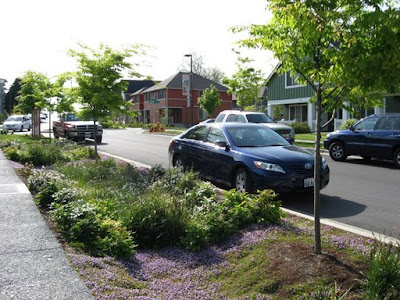From Greener Buildings, from the EPA program promoting green infrastructure, including a new report 'Managing Wet Weather with Green Infrastructure', "...lists the numerous green infrastructure options available and the benefits of putting them in place. The pluses to utilizing green roofs, vegetated medians and other other approaches include cutting down stormwater runoff, reducing sewer overflows, creating urban habitats and improving air quality."

:: image via US EPA
A Green Infrastructure program by American Forests features a project analyzing urban form via satellite imagery, specifically A planimetric map of a Washington DC neighborhood shows a neighborhood’s gray infrastructure including buildings and roads (left). Classified high-resolution satellite imagery adds a green infrastructure data layer (trees and other vegetation) with its associated environmental benefits (right).

:: image via American Forests
Also, Brice Maryman from Seattle (one of the minds behind Seattle Open Space 2100) clued me into the Green Infrastructure Wiki, outlining an approach for gleaning (and more importantly organizing in a coherent pattern, green infrastructure concepts and case studies). The information is setup in: "...a framework made up of 5 interconnected systems: habitat, community, water, mobility, and energy & materials. Each system is made up of green infrastructure elements. These elements are not discrete from one another in the precise way of chemical elements. Some are irreducibly multi-functional and defy clean categorization. Others have specific purposes."
Information is organized into system groups and given a designation, similar to chemical elements. For instance:
SYSTEM 3: WATER includes:
3RG RainGarden, 3Bs Bioswale, 3SP StormwaterPlanter, 3Wp Wetpond, 3Dp Drypond, 3CW ConstructedWetland, 3GR Green Roof, 3Ci Cistern, 3FS Filter Strip, 3PP PorousPavement, 3GA GreenAlley.
The idea of a periodic table of concepts is interesting, much like a pattern language or other form for being able to both define and show relationships between items and related concepts. These provide basic information such as terminology, performance criteria, diagrams, as well as links to notable projects.

:: image via Green Infrastructure Wiki
The conceptual shift from gray to green, such as is the main thrust of green infrastructure provides a new understanding of systems of cities. There are multiple benefits that green infrastructure offers over it's counterpart. From Green Values Stormwater Toolbox:
Green Infrastructure Saves Money:
Green infrastructure performs many of the same services as gray infrastructure, such as stormwater management, flood control and water quality, but often at a reduced cost and more reliably. Cost savings is critically important, as the USEPA, General Accounting Office and American Society of Civil Engineers agree that the nation needs to spend between $300 billion and $1 trillion to fund drinking and wastewater needs over next 20 years.
Green Infrastructure Supports Sustainability:
Wetlands, parks and other types of open spaces are a critical component of the sustainability of a region. Just try to imagine a neighborhood or community without a park or trees. Hard to do, isn’t it? And yet park districts and forestry and natural resources divisions face a constant struggle to obtain the necessary resources to fund these spaces. If treated as infrastructure, however, open spaces and recreational areas could be treated as an investment, not an expense.
Green Infrastructure Better Uses Limited Resources:
Governments not only spend less to install and maintain most green infrastructure, green infrastructure provides a host of ancillary benefits, such as increased recreation and open space, community building opportunities and better air and water quality."
The shift is happening for the above reasons, as well as the development of actual projects, with good planning and scientific research that confirms these points. In order to take full advantage of this, we need to continue to clarify what green infrastructure is, as well as broaden our scope and horizons about the potential applications. Beyond site scale is neighborhoods and communities, and whole cities using green infrastructure principles. By using resources such as the Green Infrastructure Wiki, GreenInfrastructure.net, as well as existing LID and Stormwater management techniques, we can use this information to define the profession for the next hundred years and beyond.
Perhaps until Green Infrastructure loses its verdant moniker - and becomes, merely - infrastructure.

No comments:
Post a Comment